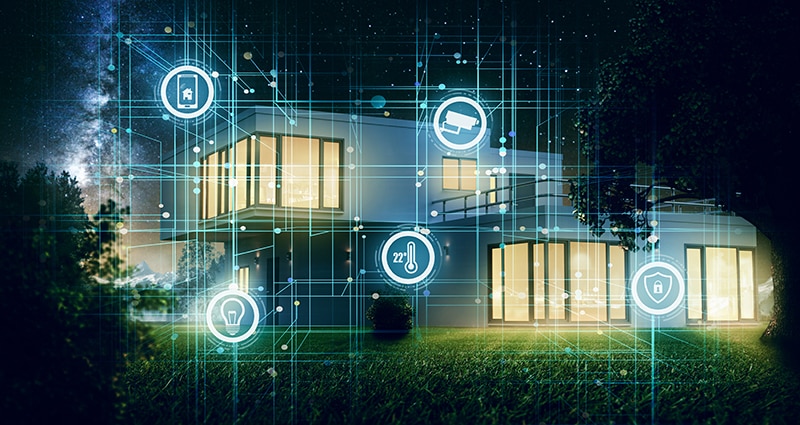What Makes a Smart Home? A Guide to Protocols and Applications
Smart homes are created by well-matched devices and communication protocols
This is a summary of an article from a five-part series about the technologies that enable IoT. The full article can be viewed at wevolver.com.
Introduction
Thanks to advancements in technology, the definition of what a “Smart Home” is, has continued to evolve with increasing applications and capacities. However, what has remained constant is that smart homes are made of multiple systems working together to make the home automated, comfortable, and stress-free.

In recent times, a key driver of the transformation of Smart Home systems has been the internet of things (IoT). The IoT came with the promise of us being able to connect elements and objects in our environment to the internet. That has led to a huge and dynamic transformation across many sectors/verticals, including the Smart Home. Thanks to the IoT, smart home devices that previously just shared data just with one another, and within the confines of the home, can now share data on the internet. This allows smart home users the ability to interact with their homes and infrastructure in real-time, from wherever they are. This has made smart home solutions “smarter” and created an avenue for several new applications, leveraging cloud computing and machine learning/AI (Artificial Intelligence) to process data, evaluate scenarios in real-time, and make smart decisions beyond the typical pre-programmed logic. These potentials are being harnessed and have led to the emergence of several new smart home devices/solutions.
The major enabler of smart home systems and the journey to being IoT-enabled are the communication protocols. They provide the infrastructure and dictate the terms by which devices communicate to automate things around the home. This article will provide a guide to the communication protocols and standards enabling the current trends in smart homes.
Smart Home Communication Protocols
Smart Home Applications are built around the ability of multiple devices, sensors, actuators, etc., to talk to one another. From the thermostat talking to the air conditioner to regulate the temperature in the home to motion sensors turning off the lights in an empty room. This makes communication protocols an integral part of smart home applications. However, due to variations in features, capabilities, mode of operation, and requirements, several communication protocols are adopted by manufacturers for various applications. Some of the popular Smart Home communication protocols include;
-
WiFi
-
Zigbee
-
Z-Wave
-
BLE
-
Matter
Architecting Smart Home Solutions:
Understanding the relationship between communication protocols and IoT Smart Home Application
While trivial factors like the manufacturer’s preference (the desire to create a line of products with the same protocol etc.) sometimes contribute to the decision-making process, the choice of a communication protocol for smart home systems is ultimately always dictated by the requirements of the application. Some of the features of the application that determine the protocols used include;
-
Data Volume
-
Power
-
Operation Cycle
-
Platform Compatibility
-
Cost
Bringing it together: Smart Home Hubs and Multi-Protocol Hubs/Gateways
Having multiple smart home devices spread across different applications in the home quickly becomes a lot to manage. Different control/interface for each application wears out the user and prevents the attainment of the level of sync that should exist among smart home applications to make the home truly smart and autonomous.
To solve this, Smart Home Hubs were developed. Smart Home Hubs (bridge or gateways) are hardware devices that allow users to unify their smart home devices so they can be controlled from a single interface.
Beyond the ability to access multiple devices/applications from one interface, hubs allow users to create relationships and interactions between those devices/applications. For devices based on protocols that are not IP-based, hubs are sometimes used to get data from the devices to the internet (and vice-versa).
However, the existence of hubs further revealed the interoperability challenges that have plagued smart home systems due to the multiple protocols. For example, if you get a few Zigbee-based smart home devices with a Zigbee-based hub, you are “not allowed” to fall in love with a set of other devices/applications based on another protocol other than Zigbee unless you plan to get another hub based on that protocol or run those devices/applications as standalone.
Multi-Protocol hubs/gateways like the Samsung Smartthings hub and the Wink hub 2, which allow users to interconnect devices based on multiple protocols including Zigbee, Z-wave, WiFi, etc., provide a way around this problem but they come at an extra price that puts an additional burden on the users and hinders the adoption of smart home solutions.
The interoperability challenges, among other factors, and their effects on Smart Home adoption make the need for protocol/standards unification necessary and this is where a protocol/standard like Matter comes in.
Matter: Why it Matters
According to research conducted by Google and Accenture in 2020, one of the major barriers to smart home adoptions is the lack of interoperability amongst smart home solutions. According to the report which focussed on the Asia Pacific region; “consumers are either not purchasing devices due to a lack of understanding or not using them to their full extent. In many homes, devices are largely disconnected from one another, meaning the experience is not as seamless, and their smart capabilities are not being fully used”. This is a problem that is clear to all, and smart home solution providers/manufacturers have, over time, made attempts to create a unifying standard/protocol by coming together to form alliances. A good example of this is the Zigbee alliance.
While a good amount of progress was made, the fundamental challenges with some of the protocols on which the alliances were built, reduced their viability and prevented the alliances from reaching their true potentials.
This is where Matter comes in, a communication standard architected with simplicity, security, and the kind of elegance required to make homes truly smart and interconnected.
Matter ticks all the boxes the previous alliances and standards failed to.
Aside from being a protocol that is supported and co-developed by the major players in the smart home industry (a rare feat), Matter extremely matters for the future of IoT-based Smart Home systems because of its Open nature and IP-Based architecture which gives each device a unique address. These two factors would reduce the complexities in solution deployment and address issues of security and privacy, leveraging on the robust work already done for other IP-based protocols.
Conclusion
Smart home systems are defined by the applications, and as technology continues to advance, especially with the Metaverse now upon us, the applications and capabilities will evolve and become more complex. Communication protocols will keep playing an integral role in these transformations, as such, they must evolve too. The need for a truly integrated smart home experience will increase and with more home devices connected to the internet, the concerns about security, privacy, energy efficiency, etc., will deepen. As such, for a true, integrated smart home experience, protocols that benefit from all-around knowledge available for security, enable high-level privacy, easier deployment, and improved interoperability needs to come into play.
The full version of this article can be viewed at wevolver.com.

Have questions or comments? Continue the conversation on TechForum, DigiKey's online community and technical resource.
Visit TechForum







